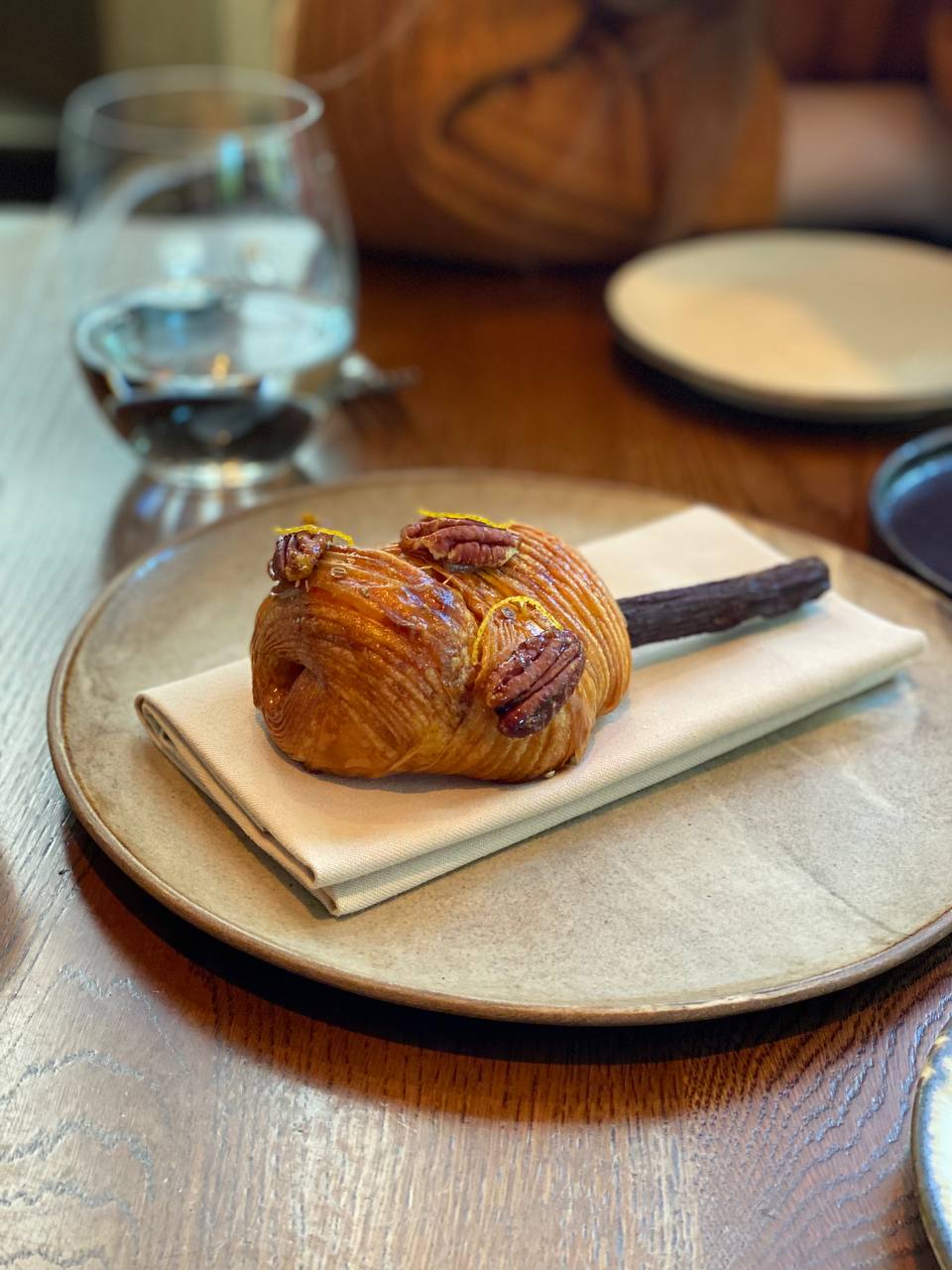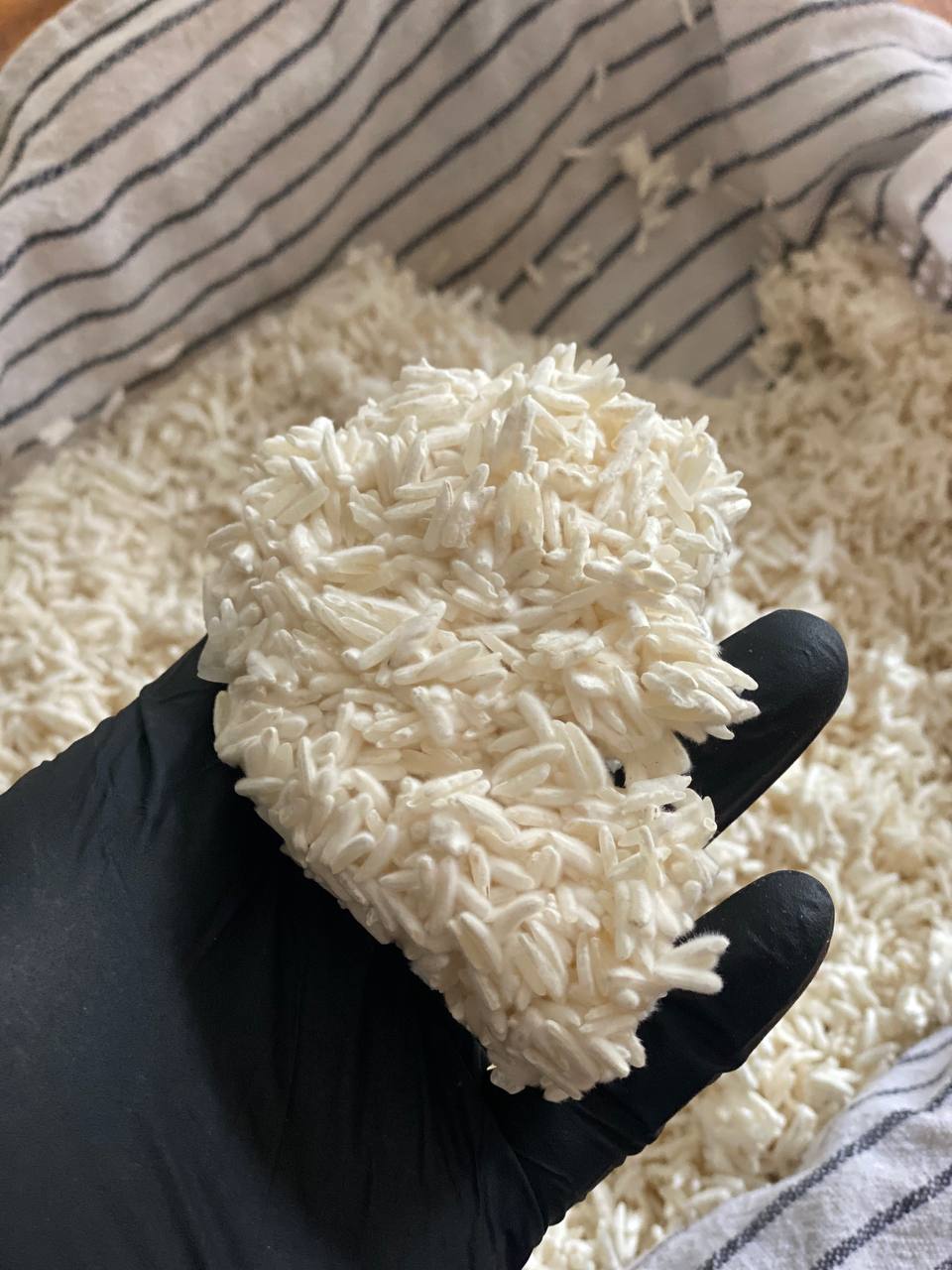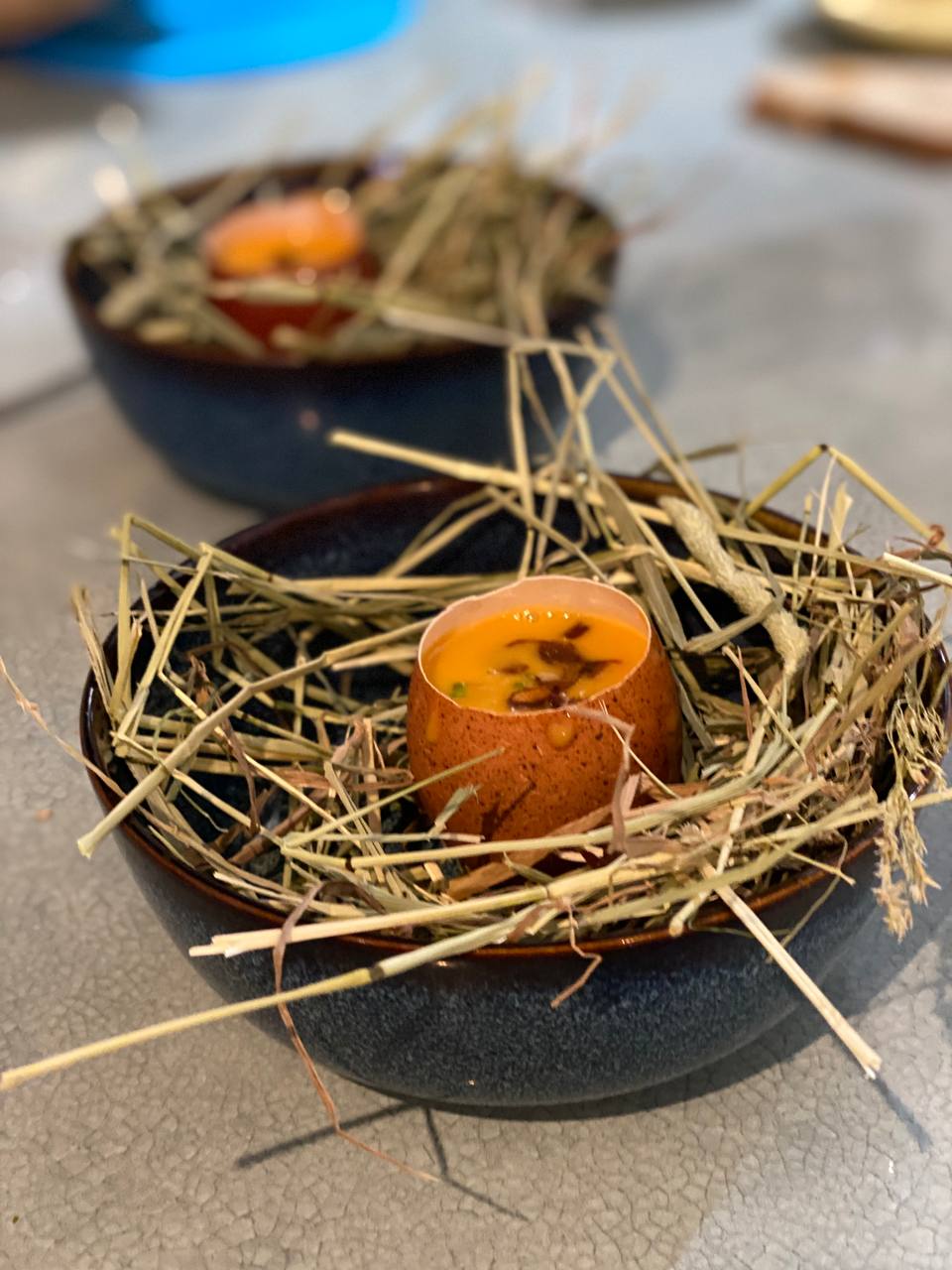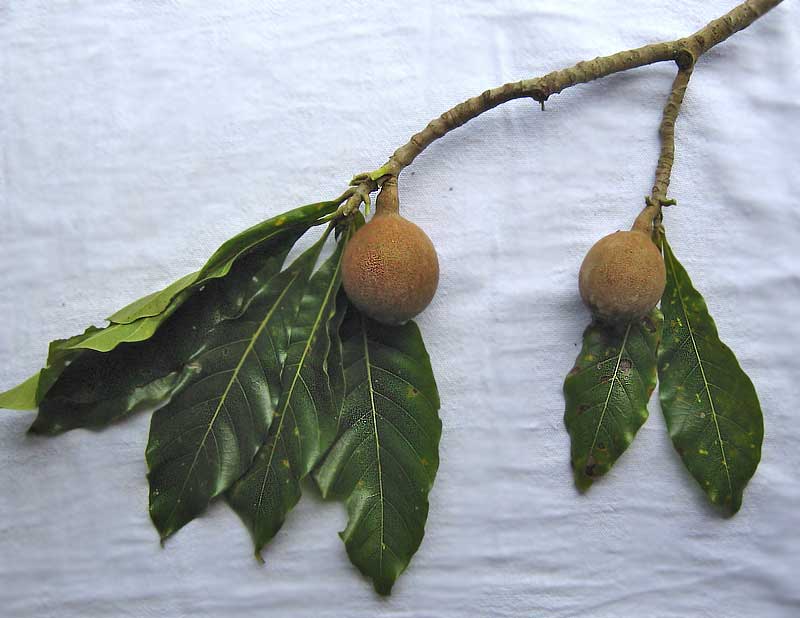#116
On new flavours
Over the weekend Sasha took me for a breakfast date, and to my knowledge there is only one Michelin-starred restaurant in London that servers breakfast, so ther we went.
I was a tad sceptical about Hide, mostly because in their early days there weren't that many favourable reviews, but seems like it got better with time.
The eggs were cooked to perfection, and the pastries were crunchy and flavourful.
The combination of truffles and eggs isn't new for me, but as the white truffle is in season I was pleasantly surprised that the folks used it sparingly:

This birch sap croissant is served impaled on a burnt licuorice root stick, to add up to the flavours:

Back home I also kicked off my second batch of koji and they look beautiful (although I don't have definitive plans on them yet).

And last but not least, we stopped by out friends' over the weekend and got treated to a proper tasting set cooked and plated in front of us.

Pictured is essentially a cheese and egg mousse with mushrooms, and it's as delicious as it looks.
Enjoying this? Get Tuesday Triage in your inbox every week.
Things I enjoyed reading
1. Why read Dostoevsky? A programmer's perspective by https://twitter.com/fernandohur
Dostoevsky is one of my favourite authors and reading about it from a programmer's perspective was a nice way to gain a yet another insight into my appreciation for his work:
Part of Crime and Punishment's (CaP) genius is in Dostoevsky's depiction of the psychology of a man who's thinking of doing something very wrong and eventually does it. If you've ever done something really wrong (most of us have), something that your conscience has screamed you not to do, you will identify with CaP's protagonist's descent into psychological darkness.
These days I'd recommend reading his Demons first. It's as much a satire as it is a tragedy, and yet in 2022 it makes way more sense.
2. Build Your Career on Dirty Work by https://twitter.com/staysaasy
A very good advice for anyone aspiring to move up the career ladder.
Another place people often overlook is QA, particularly QAing other people’s work. I love QAing other people’s work - it’s one of the best ways to learn about the product and to prevent issues from going out.
I would also add that no matter how "dirty" the work is, the first step is always making sure that people actually care. Some companies built a culture where things don't get recognised, in which case there is little point in bothering.
3. A Guide to the Best Apples for Apple Pie by https://twitter.com/kenjilopezalt
An article with a good old Kenji vibe, focused on testing various apple varieties to come up with the best one suitable for pies.
It all has to do with air. Braeburns are relatively dense apples, with not much air in between their cells. (You can see this if you drop one into a bucket of water along with, say, a McIntosh: Braeburns will float up much more slowly.) Apples with lots of air will collapse on themselves, like a deflating balloon, as they cook. Very dense apples—like Braeburns—will retain their shape better, even as they completely soften.
The varieties are probably different across the pond, but it's quite easy to reproduce the results of the experiment using local ones (or even a completely different fruit altogether).
4. What it Takes to Make a Game by Yourself by https://twitter.com/DillonShook
I always envy the dedication of people who decide to make their own game (and then also ship it, but shipping things in general is something I jelous of anyway), and this is a very detailed analysis of the process itself:
A good forcing function for keeping the game simple while designing it was adding tutorials for each stage. It became pretty obvious that if I couldn’t explain what to do in a few pop up tutorials then I had made the game too complicated.
I also really liked the reasoning behind adding tutorials. A proper onboarding is as vital as the clear business model.
5. Tappūtī-Bēlet-ekallim, The Oldest Perfumer on Record by Nuri McBride
Despite not being a huge perfume fan, I learn a thing or two reading about its history:
The fact that Tappūtī-Bēlet-ekallim is named at all is significant. We have older perfumery documents from across Mesopotamia. However, palace workers, even skilled workers like perfumers, were often not named in written records. This was especially true of perfumers that came to Aššur through conquest. Often, they are referred to by their city or nationality of origin (example: the Assyrian perfumer).
On the side note, I can't get used to historians' obsession with people names and the amount of information they can derive from it. I wonder how will that profession look like in a few centuries.
6. The art of menus by Jonathan Meades
While some historians learn from names, other use food menus, and apparently they can tell a lot:
In the mid-1990s the fabric of quotidian life suggested that the ‘former’ east was not really former at all. East of the Elbe it all looked, smelled and tasted like the old indigent DDR which was already inciting ostalgie. A comforting clumsiness infected packaging, colour-blind fabrics, fat lava ceramics, childlike posters, glassware, excitingly patterned housecoats and menus littered with anthropomorphic animals, anthropomorphic cartoon figures, puppets, diagrammatic samovars and onion domes (Russian restaurants) and guitars (Cuban).
An interesting idea is that menus don't necessarily tell you about the past but also show hints on the nearby future, so they could help in tracking down the trends too.
7. Giant plants make epic journey from Edinburgh to Port Logan by Giancarlo Rinaldi
A full of pictures report on transferring some very tall plants from one botanical garden to another:
Prior to being transferred, the two-metre long fronds at the top of each fern were removed then the top four metres of each "trunk" were carefully taken out and prepared for their long journey.
It doesn't seem to be a very complicated process but when you think how many things could go wrong you start appreciating software engineering a bit more.
8. The 4 minute bug by Alejandro AR
Not everything in software engineering is as straightforward though, and while some bugs require a simple character change, the most annoying (and yet rewarding) are the once that turn you into a detective and force to hunt them down across decade-old forums and abandonded code modules.
When digging deeper we noticed that there were some calls made on a helper to our exchange rate service that was pretty constant. We saw peaks from months ago, and the trend was always the same: every hour, at minute zero, there was a peak in calls to the service for 4 minutes, and then it stopped until the next hour. Sounds familiar?
This one has a pretty fun cause and lots of potential learning (mostly about the importance of good documentation).
9. How the Little Ice Age Changed History by John Lanchester
While these days we mostly worry about the global warming, a few centuries ago folks had a completely opposite problem:
In Europe, rivers and lakes and harbors froze, leading to phenomena such as the “frost fairs” on the River Thames—fairgrounds that spread across the river’s London tideway, which went from being a freakish rarity to a semi-regular event. (Virginia Woolf set a scene in “Orlando” at one.) Birds iced up and fell from the sky; men and women died of hypothermia; the King of France’s beard froze solid while he slept.
The article touches up on potential causes a bit, and seems like we can't really protect ourselves from it happening again anyway.
10. How Do You Make the Perfect Toy? by Matthew Brag
A very interesting look behind the curtains of toy making, as well as a thorough explanation of how the users' interest works.
The less restrictive and more flexible the toy, the better. In one example, the researchers found that a wooden cash register encouraged children to talk about buying and selling items, whereas an electronic one with lights and sounds encouraged them to press buttons instead—more entertainment than engagement.
Researching for toy-making companies must be fun. I wonder if folks feel like this kind of job is more rewarding than an average 9-5?
Did you know I make apps?

Silk
Track patterns in your intimate life without judgment. Partner profiles, health insights, and analytics — all encrypted and hidden behind a calculator.
Take a look →Things I didn't know last Tuesday
1. Hallgrímskirkja
I know very little about Iceland but the landscapes were always mesmerising. Seems like the architecture too:
Hallgrímskirkja is a Lutheran (Church of Iceland) parish church in Reykjavík, Iceland. At 74.5 metres (244 ft) tall, it is the largest church in Iceland and among the tallest structures in the country.

Also despite never visiting it before, Iceland is probably one of the very few countries I'd love to live at.
2. God's Own Country
And speaking about countries, lots of them argue which one is the God's own, usually referring either to Bible or to poets. And this version is my favourite:
The phrase is also, and perhaps most famously, used to describe Yorkshire, England's largest county. This is used interchangeably with "God's Own County", a term first used by the writer Nigel Farndale, himself a Yorkshireman, as a headline in a special Yorkshire edition of Country Life magazine in 1995.
It's relatively new though, so given enough perseverance one could change it to be something else, like Bray or Peckham (please don't).
3. Sauna use appears to reduce morbidity and mortality
A very detailed research paper looking into benefits of saunas. To be fair it's convincing enough to reconsider my stance on redundant post-workout activities.
Of particular interest are the findings from large, prospective, population-based cohort studies of health outcomes among sauna users that identified strong dose-dependent links between sauna use and reduced morbidity and mortality.
On the other hand, that's easily thirty minutes more to a gym visit, which sounds quite a lot.
4. Cobra maneuver
The explanation does it less judgement than the picture, but even static illustrations look pretty cool:
[...] a dramatic and demanding maneuver in which an airplane flying at a moderate speed abruptly raises its nose momentarily to a vertical and slightly past vertical attitude, causing an extremely high angle of attack and momentarily stalling the plane, making a full-body air brake before dropping back to normal position, during which the aircraft does not change effective altitude.

It's a smart blend of both physics and airplane technologies, which makes it stand out for me.
5. Becoming a father shrinks your cerebrum
Another unexpected (to me) research on how father's body changes with a birth.
They confirmed that there is a small but consistent decrease in the volume of the cortices of new fathers after the birth of their child. This shrinkage is not, however, evenly distributed.
There are more details to it (and more research pending) but at least it means we can control our brains' structure without any physical intervention.
6. Jagua
A fruit used to make everything from wine to tattoos:
This yellow-orange fruit ranges in size from kiwi to melon, and tastes like dried apple or quince when ripe. Central and South Americans use jagua in sweets, wine, syrups, and liquor, but—most specifically—for its vibrant natural dye.

It's juice is transparent when unripen though. Probably it might have a smart usage for colour-changing cocktails, even though I am not a big fan of those (but that's a different story).
7. The first rubber balloons were made by Professor Michael Faraday
Faraday pretty much established the basis for the concept of the electromagnetic field in physics... and also invented the first rubber balloon.
Faraday made his balloons by cutting round two sheets of rubber laid together and pressing the edges together. The tacky rubber welded automatically, and the inside of the balloon was rubbed with flour to prevent the opposing surfaces joining together.
Up until then kids had to use pig bladders and animal intestines.
8. Stave Church
Another Nordic example of beautiful church architecture:
A stave church is a medieval wooden Christian church building once common in north-western Europe. The name derives from the building's structure of post and lintel construction, a type of timber framing where the load-bearing ore-pine posts are called stafr in Old Norse (stav in modern Norwegian).

What's interesting is that there are almost zero example of stave churches outside of Norway. Researchers think there were more of them but they didn't survive for so long.
9. People worried that the electric push button would make human skills atrophy
When push buttons were inventeed folks thought it's too easy to be good:
Plotnick quotes an educator and activist from 1916 lamenting that pushing a button “seems to relieve one of any necessity for responsibility about what goes on behind the button.”
What happened next? They probably invented an elevator.
10. Elixir sulfanilamide
Another example of drug making gone wrong:
Elixir sulfanilamide was an improperly prepared sulfonamide antibiotic that caused mass poisoning in the United States in 1937. It is believed to have killed more than 100 people.

As the result, laws became way stricter to control drugs production.
Book of the week
I am still not quite at the point where I'll start nixtamalising my own corn, but I do consider growing koji on it so thought I would first have a look at what other chefs are doing.
There are not that many books going into the actual details and chemistry of masa, and Jorge Gaviria's Masa: Techniques, Recipes, and Reflections on a Timeless Staple is a rare exception:
Let’s get the birds and the bees of nixtamalization out of the way and demystify this all together as mature adults. Corn meets cal (in a hot tub, no less). Things get hot. Clothes (in this case the corn’s skin, or pericarp) start coming off. Hours later (yes, hours, depending on how long everyone feels comfortable hanging out in tepid cal water), you have nixtamal babies.
One of life’s greatest natural wonders, corn nixtamalization is made possible through the union of corn and cal in a hot bath.The hot water is the bridge, the matchmaker, between our two star-crossed ingredients, corn and cal.
It's an easy read, and there are enough recipes to keep one busy when the theory becomes too boring (if ever).
I also appreciate a bunch of advice spread throughout the chapters, from simple tricks to make tortillas puff to DIY replacements for corn grinders.
Although I must say that I am not convinced about making masa at home yet.
Thank you and see you in a week
(or in a month)!
If you'd like to support the newsletter, please subscribe to the weekly plan. Otherwise you will keep receiving the letters on a monthly cadence – no need to do anything to opt-in.
If you have any questions, or want to suggest a link for the next newsletter, please drop me a message on Twitter or reply to this email.
Cheers! 🍸
Need help with iOS?
I spent a decade on FDA-regulated medical devices and apps with millions of users. Now I help teams ship MVPs, rescue messy architectures, and build the hard bits that don't fit in a sprint.
Learn more →